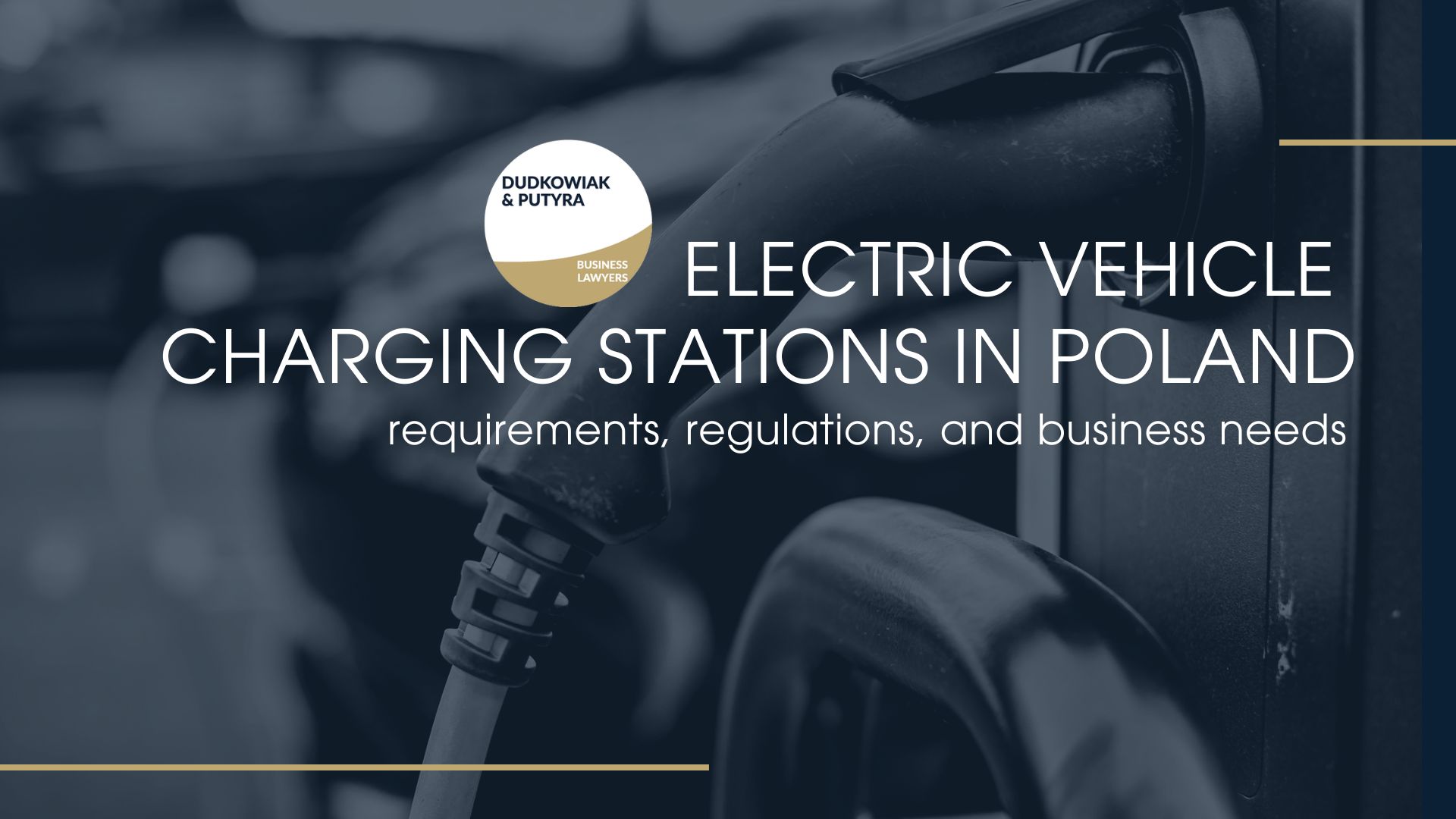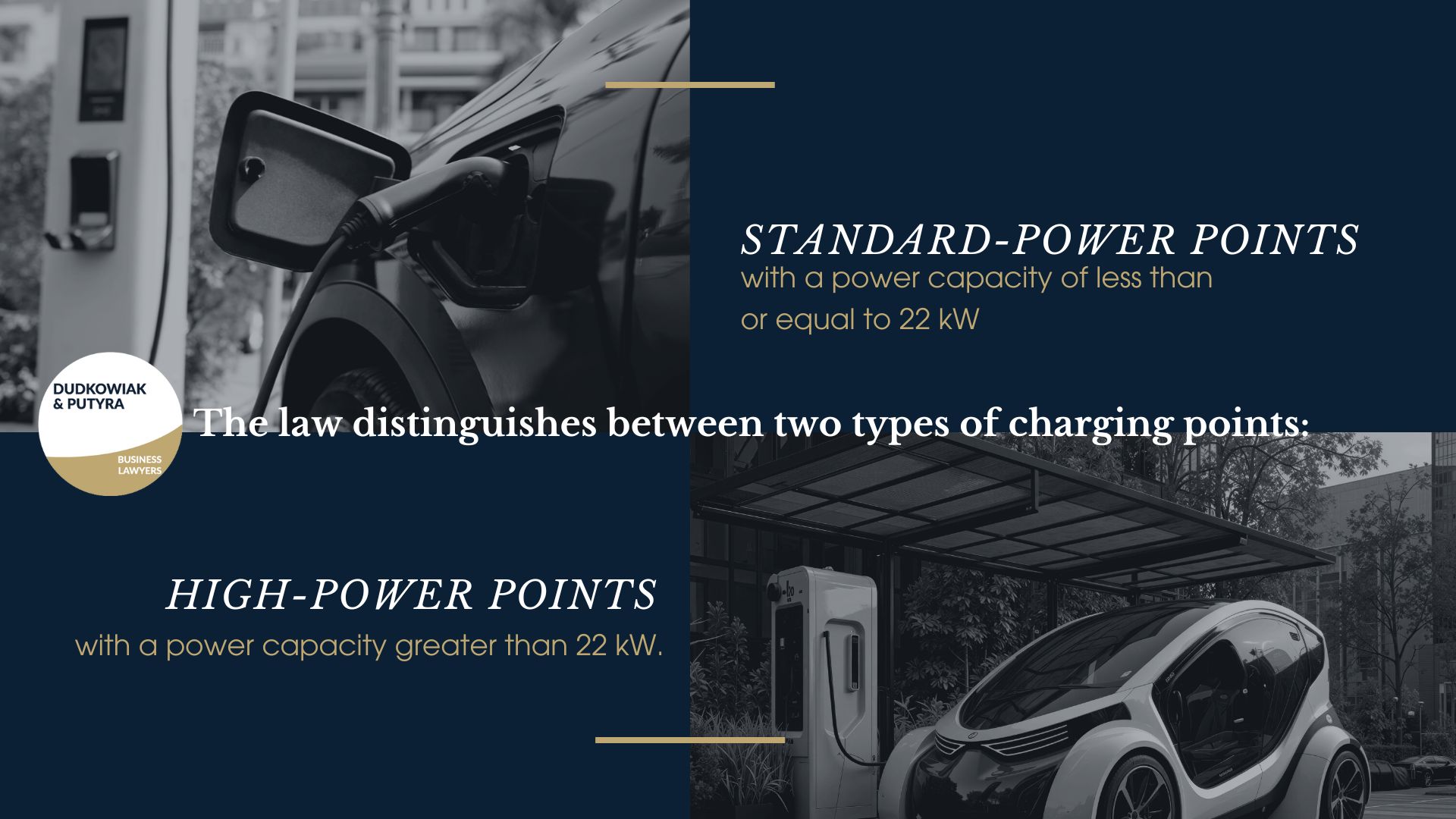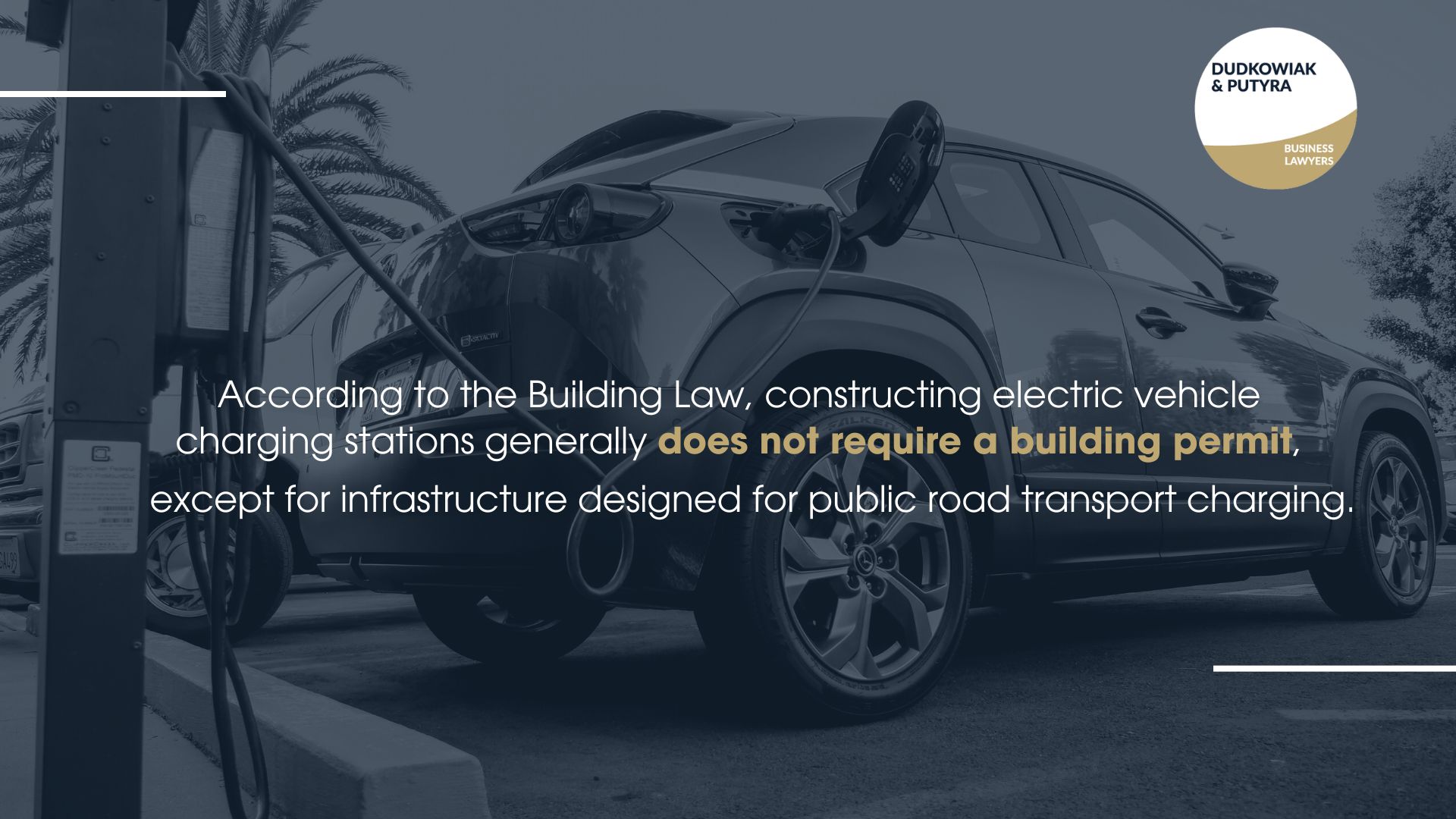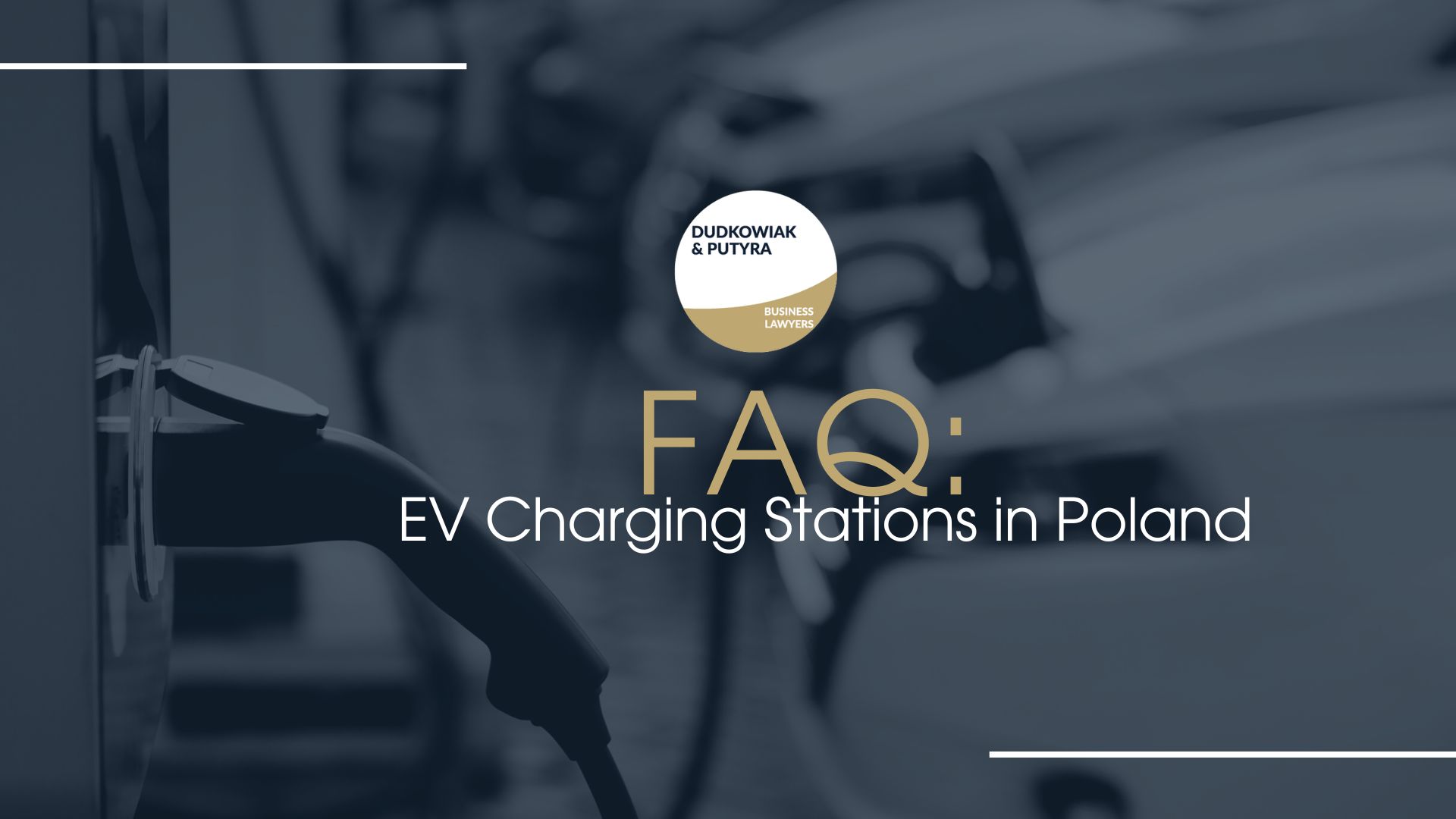Last updated: 01.10.2025

Electric Vehicle Charging Stations in Poland: Key Regulations and Requirements
The development of electric vehicle (EV) charging infrastructure is a key element in the transition towards zero-emission transportation.
The rapid growth in the number of EVs is driving businesses to adapt to the increasing demand for charging stations. Polish regulations concerning charging infrastructure, particularly the Act on Electromobility and Alternative Fuels and the Ministry of Energy Regulation of June 26, 2019, set out the technical and formal requirements that charging station operators must meet.
The fundamental component of the infrastructure is the charging point, which the Act on Electromobility defines as a device enabling the charging of a single electric vehicle, hybrid vehicle, or zero-emission bus.
Additionally, a charging point may also serve as a place for replacing or charging the batteries that power these vehicles.
In practice, EV drivers choose between AC points for longer stops and DC (direct current) points where charging speed and short charging time are critical.
The law distinguishes between two types of charging points:
- standard-power points – with a power capacity of less than or equal to 22 kW, excluding devices with a capacity of less than or equal to 3.7 kW installed in locations other than public charging stations, such as in residential buildings,
- high-power points – with a power capacity greater than 22 kW.

This distinction is crucial for both businesses and EV users, as different types of charging points are tailored to specific needs – ranging from home charging of personal vehicles to fast charging of vehicle fleets and buses in public spaces.
For example, companies operating in heavy traffic corridors prioritize high-power DC infrastructure to help drivers save time and optimize route planning.
EV Charging Station vs. Charging Point: Key Differences Explained
Although these two terms are often used interchangeably, the law clearly distinguishes between a charging station and a charging point.
According to the legislation, a charging station is a building structure that includes one or more charging points – either of standard or high power. It can be a standalone facility or an installation connected to another building structure.
A charging station must be equipped with software that enables the provision of charging services, and if connected to the distribution grid, it must also include an installation leading from the charging point to the electrical connection.
Public EV Charging Stations in Poland: Requirements and Accessibility
In the Polish legal framework, public charging stations are specifically designated and must be available on an equal basis to all users of electric and hybrid vehicles.
This means that anyone with an appropriate vehicle has the right to use these stations, regardless of the operator or location. Such stations play a strategic role in developing a nationwide charging network, as their public nature facilitates access to charging, which is crucial for the growth of electric vehicle numbers.
Technical and Operational Requirements for EV Charging Stations
According to the Act on Electromobility, operators of public charging stations are required to meet a range of technical and operational standards.
First and foremost, stations must comply with Polish technical norms that ensure safe usage. These requirements, as stipulated in Article 13 of the Act on Electromobility, include:
- fire safety,
- safe operation of the electrical grid,
- accessibility for people with disabilities.
Additionally, operators are responsible for ensuring that the charging stations undergo technical inspections by the Office of Technical Inspection (UDT), both before being put into operation and after any repairs or upgrades.
These inspections are not conducted automatically but must be requested by the concerned entity, which is also required to provide the necessary documentation.
EV Charging Station Management and Reporting Systems
Charging stations must be equipped with software that not only enables vehicle connection and charging but also transmits data to the Register of Alternative Fuel Infrastructure (EIPA).
This register, maintained by the President of the Technical Supervision Office (UDT), is a public database containing information about charging stations, the availability of charging points, and service prices, helping users plan trips and access the charging network more easily.
Additionally, each station must have a metering system that allows for the measurement of electricity consumption and the real-time transmission of this data to the station’s management system.
Formal aspects: construction and operation of charging stations
For businesses planning to build charging stations, a key point is that offering charging services does not constitute the sale of electricity, meaning no energy trading license is required.
According to the Building Law, constructing electric vehicle charging stations generally does not require a building permit, except for infrastructure designed for public road transport charging.

In most cases, only a construction notification is required, which must be submitted to the architectural and construction administration authority. The notification should include information about the type, scope, location, and method of the work, as well as the start date. If the authority does not object within 21 days of receiving the notification, the business can proceed with the investment.
Signage and maintenance of charging stations
Every charging station must be properly labeled. The equipment should feature a nameplate containing details such as the manufacturer’s name, serial number, voltage, and rated frequency. Station operators are also required to ensure regular technical inspections and maintenance, as well as perform necessary electrical measurements to guarantee safe usage.
Key challenges for entrepreneurs investing in EV charging station in Poland
From the perspective of entrepreneurs investing in electric car charging infrastructure, it is crucial to understand and meet the technical and formal requirements for the legal and safe operation of the stations.
Investors must keep in mind:
- technical inspections conducted by the UDT,
- ensuring safe operation in accordance with Polish standards,
- proper data management and reporting to EIPA.

Although this process involves certain obligations, the prospects for the electric vehicle charging market are promising, with demand for these services growing as the number of EV users increases.
The Future of EV Charging in Poland: Highway Corridors and Europe-Wide Expansion
The development of highway corridors in Poland is crucial for the future expansion of the country’s EV charging infrastructure. These corridors will ensure fast and accessible charging options along key highways, making long-distance travel more convenient for EV drivers.
As Poland strengthens its charging network, it will become an integral part of a larger Europe-wide network, supporting the growth of electric vehicle adoption across the continent. This collaborative effort will not only enhance the infrastructure but also promote a cleaner, more sustainable future for transportation in Poland and beyond.

FAQ – EV Charging Stations in Poland
What are the key requirements for EV charging stations in Poland?
According to the Act on Electromobility and Alternative Fuels, EV charging stations must meet various technical and operational requirements, including fire safety, safe electrical service, and accessibility for people with disabilities. Operators must ensure that their stations undergo technical inspections by the Office of Technical Inspection (UDT) before opening and after any updates. These stations can be located in key areas such as residential applications, commercial applications, or at joint office locations.
What types of connectors are used at EV charging stations in Poland?
In Poland, the most commonly used connector types are Type 2 (AC) and CCS (Combined Charging System, DC). CCS connectors are typically used for fast chargers, providing high-speed charging, which is essential for long-distance travel. Type 2 connectors are generally found in residential applications and public spaces. The combined charging system ensures compatibility across different vehicle models.
How can I find EV charging stations in Poland?
To locate installed stations, you can use the station locator app or website, which provides a map of all available charging stations. The map includes information on connector types, charging speed, and the distance between stations. This helps users plan trips and find the nearest charger based on customer needs. You can search for stations by location, note their availability, and see their status in real-time.
How long does it take to start charging an electric vehicle at a public charging station in Poland?
The time it takes to start charging depends on many factors, such as the connector types, charging level of a battery, the vehicle’s battery size, and the charging power.
Fast chargers with DC connectors typically charge vehicles much quicker, with rapid charging times ranging from 15 to 40 minutes to 80% capacity.
In contrast, AC charging may take several hours depending on the installed infrastructure and battery capacity.
How can I be sure that my EV will be compatible with the charging stations in Poland?
Poland’s charging stations are designed to be compatible with a wide range of EV models and offer various connector types such as Type 2 for AC charging and CCS (DC) for fast charging. This ensures that most EVs on the market, including Tesla vehicles, can easily charge at any station in the country. Apps and station locator tools also help users verify the connector types available at each station before they start charging.

